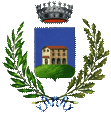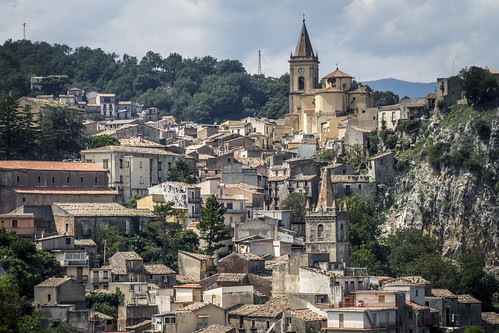

Il nome Basicò rimanda al greco Basilikòn, tempio o cappella regale
Le sue origini risalgono al medio e tardo neolitico tra la fine del IV e la metà del III millennio come fanno pensare i numerosi ritrovamenti rinvenuti, collegati ad insediamenti già presenti in quest’epoca, anche se il tipo di materiale recuperato dà l’idea di una frequentazione di tipo stagionale. Purtroppo i molti scopritori occasionali e i tombaroli hanno distrutto inesorabilmente i vari resti di tombe ad incinerazione rilevate a Quattrofinate e Badiazza. In contrada Fontana Fondaco sussistono tracce di mura romano-bizantine.
Le ipotesi circa la sua origine sono due: la prima ipotizza una lenta formazione del borgo attraverso la creazione di piccoli agglomerati rustici dai preesistenti casali sempre più numerosi, ed è legata alla città di Abacena; la seconda è legata alla presenza di una comunità basiliana e un monastero già nel 1150.
La prima ipotesi è considerata la più attendibile così come una derivazione dall’antica Abacena legata al mitico re Ducezio e ai tiranni siracusani Dionigi e Gerone III. Il suo nome deriva dal punico Abac (elevare), al momento non si conosce l’esatta ubicazione ma si ipotizza la sua allocazione sotto le mura di Tripi.
I comuni dei dintorni, Novara di Sicilia, Tripi, Furnari, Montalbano Elicona e Basicò sembra abbiano una stessa origine abacenina. Abacena non era un’unica città strettamente circoscritta, ma piuttosto un territorio con un sistema organico di piccoli agglomerati urbani ravvicinati, sul modello delle più antiche e celebri città greche organizzate in “ demi “, o di quelle latine.
Nella seconda metà dell’anno mille si poté assistere ai primi sbarchi normanni sulla costa tra Capo Tindari e Capo Milazzo, come dimostrano le tracce sussistenti nel comprensorio dal predominio degli Altavilla ad avvalorare l’ipotesi che il Demone sia stato il più normanno dei tre Valli siciliani.
Durante la dominazione normanna sorsero molte fortezze sia nei territori interni che lungo la fascia costiera e molti monasteri. In questo periodo fu eretto a Basicò, per volere reale, il Convento delle Clarisse, Santa Maria di Basicò, retto da nobili dame alcune imparentate con Federico II. Ma con la sconfitta degli Svevi e l’avvento degli Angioioni e quindi la lotta contro gli Aragonesi ne determinano la caduta. Il casale ed il convento furono saccheggiati. Le suore ripararono prima a Rometta e quindi a Messina, nei dintorni di Piazza Basicò (a monte della Via S. Agostino) dove è allocata la Fontana Falconieri.
Inizia il periodo feudale, muta il nome in Casalnuovo e vede avvicendarsi il potere delle famiglie Lancia (1350-1352), Marullo (1539-1541), poi nuovamente i Lancia e i Saccano (1554-1647), i Naselli (1648-1773) e i De Maria (con investitura ufficiale nel 1767), gli ultimi baroni persero i diritti feudali nel 1812 in seguito all’abolizione delle baronie in Sicilia.
Nel 1860 il paese diviene Comune d’Italia con il nome di Basicò.
(English)
The name Basicò refers to the Greek Basilikòn, temple or royal chapel.
Its origins date back to medium or to the late Neolithic period between the end of IV and the middle of III millennium, as the numerous findings founded suggest, connected to settlements already presents in this period, although the type of material recovered seems of a seasonal attendance. Unfortunately, occasional discoverers and the tomb raiders had destroyed inexorably the various the remains of cremation tombs, discovered to Quattrofinate and Badiazza. In the district Fontana Fondaco exist traces of walls roman-byzantine.
The theory about this origins are two: the first suggests a slowly establishment of the borgo by a creation of little rustic agglomerations from preexisting farmhouses, ever more numerous, and it is connected to Abacena town; the second is connected to existence of a basilian community and a monastery since in the 1150.
First theory is considered more reliable, such as a derivation from ancient Abacena connected to mythic King Ducezio and to the Syracusan tyrants Dionigi and Gerone III, whose name derives from Punic Abac (to raise) and of which now is unknown exactly position but it is assumed its location under the walls of Tripi.
All the municipalities around, Novara di Sicilia, Tripi, Furnari, Montalbano Elicona and Basicò seem to have the same origin “abacenina”. Abacena, was not a single town strictly circumscribed, but rather a territory with an organic system of small small urban agglomerations close together, modeled on more ancient and celebrated greek town organized in “demes” or the latin ones.
In second middle of the year one thousand could watch to the first Norman landings on the coast between Capo Tindari and Milazzo, as shown by remains in the area, from dominance of Altavilla’s to support the hypothesis that the Demone has been the most Norman of the three Sicilian Valleys.
During the Norman Domination many fortresses arose, so in the intern areas, as along the coastline and many monasteries.
In this period was erected to Basicò, by royal will, the convent of the Clarisse, Santa Maria of Basicò, held by noble ladies, some related with Federico II. But with the defeat of Swabian and the arrival of the Angioinians, and then the struggle versus the Aragonese, caused the fall. The farmhouse and the convent was looted. The nuns fled first to Rometta and then to Messina, around to Basicò Square (upstream to Via S. Agostino), where is the Falconeri Fountain.
Begins the feudal period, change the name in Casalnuovo and sees a succession the power of the family Lancia (1350-1352), Marullo (1539-1541), then again the Lancia’s and the Saccano’s (1554-1647), the Naselli’s (1648-1773) and the De Maria’s (with official investiture in the 1767), the last barons lost feudal rights in 1812 following the abolition of Baronies in Sicily.
In the 1860 the town became Municipality of Italy with the name of Basicò.
LINK: MUNICIPALITY OF BASICÓ